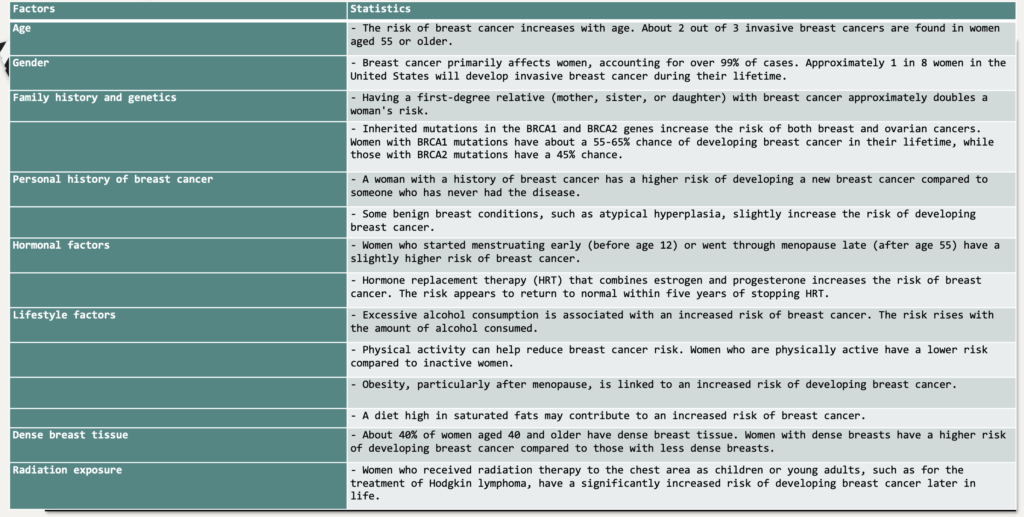Breast cancer factors
- Age
- Age and Breast Cancer Risk
- The risk of developing breast cancer rises with age. As breast cells change over time, the likelihood of cancer increases.
- Importance of Screening for Older Women
- Statistics show that about 2 out of 3 invasive breast cancer cases occur in women aged 55 or older. This highlights why regular screening is essential for older women.
- Why Risk Increases with Age
- Cumulative exposure to risk factors throughout a woman’s life contributes to the higher incidence of breast cancer in older age groups.
- Gender
- Breast Cancer and Its Prevalence
- Breast cancer mostly affects women, accounting for over 99% of cases. This high percentage is due to the amount of breast tissue in women and the hormonal influences on breast development and function.
- Breast Cancer in Men
- Although rare, men can also develop breast cancer. Awareness of this possibility is important, even though it occurs less frequently.
- Family history and genetics
- A woman’s risk of breast cancer doubles if she has a first-degree relative (mother, sister, or daughter) with the disease. This link points to the role of genetic factors in developing breast cancer.
- The Impact of Genetic Mutations
- Inherited mutations in genes like BRCA1 and BRCA2 greatly increase the risk of breast and ovarian cancers. Women with these mutations face a higher likelihood of developing breast cancer compared to those without these genetic changes.
- Personal history of breast cancer or other breast conditions
- A woman with a history of breast cancer has a higher risk of developing a new breast cancer compared to someone who has never had the disease. This may be due to genetic factors, environmental exposures, or other shared risk factors. Additionally, some benign breast conditions, such as atypical hyperplasia, slightly increase the risk of developing breast cancer. Regular follow-up and monitoring are essential for women with a history of breast conditions.
- Hormonal factors
- Hormonal factors, such as age at menarche (first menstruation) and age at menopause, influence breast cancer risk. Women who started menstruating early (before age 12) or went through menopause late (after age 55) have a slightly higher risk of breast cancer. This is likely due to longer exposure to estrogen, which can promote the growth of breast cells.
- Hormone replacement therapy (HRT) that combines estrogen and progesterone, commonly used to manage menopausal symptoms, increases the risk of breast cancer. However, the risk appears to decline and return to normal within five years of stopping HRT.
- Lifestyle factors
- Excessive alcohol consumption is associated with an increased risk of breast cancer. The risk rises with the amount of alcohol consumed. It is recommended to limit alcohol intake to reduce breast cancer risk.
- Engaging in regular physical activity can help reduce the risk of breast cancer. Women who are physically active have a lower risk compared to inactive women. Exercise is believed to have a positive impact on hormone levels, weight control, and immune function, which may contribute to reducing breast cancer risk.
- Obesity, particularly after menopause, is linked to an increased risk of developing breast cancer. Adipose tissue produces estrogen, and higher levels of estrogen can promote the development of breast cancer cells.
- A diet high in saturated fats may contribute to an increased risk of breast cancer. Consuming a balanced diet that includes a variety of fruits, vegetables, whole grains, and lean proteins is recommended for maintaining overall health, including breast health.
- Dense breast tissue
- About 40% of women aged 40 and older have dense breast tissue, which refers to the proportion of fibrous and glandular tissue compared to fatty tissue in the breasts. Women with dense breasts have a higher risk of developing breast cancer compared to those with less dense breasts. Dense breast tissue can make it more challenging to detect tumors on mammograms, as both dense tissue and tumors appear white on the image.
- Radiation exposure
- Women who received radiation therapy to the chest area as children or young adults, such as for the treatment of Hodgkin lymphoma, have a significantly increased risk of developing breast cancer later in life. The radiation exposure during treatment can damage DNA in the cells of the breast tissue, leading to an elevated risk of cancer.

